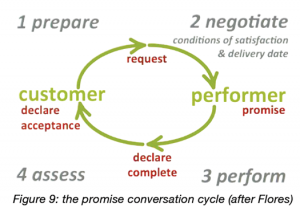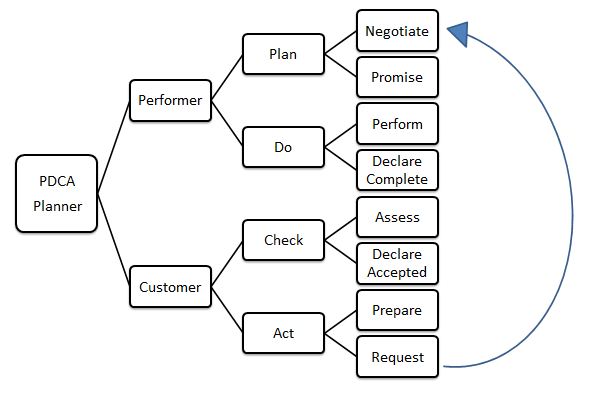Many of us use different planning instruments and schedulers. Kanban being one of the most familiar methods to readers of this blog. In the last several months, I have written about the Last Planner® (Last Planner is a registered trademark of Lean Construction Institute (LCI)) and have had several podcast on the subject most notably with Lean Construction experts and specifically with Alan Mossman discussing his latest updates in the Last Planner® – 5 + 1 crucial & collaborative conversations for predictable design & construction delivery. 
In the podcast, We don’t use a Transactional Contract for Marriage, Why for Projects?, with Alan Mossma of The Change Business we discussed The Promise Conversation Cycle. An excerpt from that conversation is in the blog post, The Discipline of Managing Promises. This conversation is the key component of The Last Planner. If we are going to create collaboration, a social process, we must define and adhere to a structure that builds trust and removes uncertainty in an uncertain world.
Our world is increasingly more collaborative driving changes in the way decisions are made. Our organizations need to change to a collaborative structure but the question is, where do we begin? I am amazed how Lean happens to be there when I am ready to use it. It reminds me of the old Buddhist proverb, “When the student is ready, the teacher will appear.” The workplace mission is defined within Toyota from the question “For whom and what type of value added products and services should be provided?” In this way, measures are created from the value added problems from the conversation.
When people consider Lean in Service Design or in Sales and Marketing, they think of Standardization. In the people word of Design and Sales, it is strongly resisted. Even in software development, I see strong resistance to the term standards. They instead call them policies. In another post, I disagreed with the terminology used in David Mann’s book, Creating a Lean Culture: Tools to Sustain Lean Conversions, Second Edition (which I consider the bible for Leader Standard Work). In the book, he allocates the time spent in standard work from a high as an operator of 95% to executive having as little as 10%. When that message is translated to services or sales many times people/organizations take that number literally and try to apply it to sales and service. I think customer facing jobs should have a high degree of flexibility and the reason for is stated very well in Dave Gray of The Dachis Group recent book, The Connected Company. He says,
Customers have a tendency to resist standardization. The more you try to standardize their service requests, the more you will anger them. Not a good recipe for customer satisfaction or long-term business growth.
Dave’s also discusses The Law of Requisite Variety stating that any control system must be capable of variety that’s greater than or equal to the variety of the system to be controlled. We will agree that the greatest variability and greatest value occur in our customer facing jobs of sales and service. If we also use the “Job to be Done “ metaphor of Clayton Christian explained in blog post, Can we drop Product and add Value to Development or Innovation?, we recognize the place of work in sales and service needs to handle the greatest variability. It seems to be a non-standard process.
Lean is a methodology, some call it culture, that is built on the scientific problem-solving method which is in Lean terms called PDCA. We form a (P) hypothesis, (D) test it, (C) measure it and (A) adjust to it. PDCA is a method that is built to handle the variability. It is a perfect match but why is it so often resisted. First, if we choose to recognize our conversation with the customer as a mini-PDCA cycle, Lean starts making sense. Earlier, we discussed the Promise Conversation Cycle; I see it as a well detailed conversation based on PDCA. However, we split the PDCA cycle in half with one side being the Performer (Seller) and the other side the Customer.
The fundamental goals of this cycle should be one of discovery, learning and adaptability with a shared responsibility for a successful outcome. That implies that it is all about engaging both organizations into effective problem solving and learning. In applying this, think of the cycle in terms of a series of iterative loops of problem solving and knowledge creation. For a more detailed explanation of this refer to blog post, SALES PDCA Framework for Lean Sales and Marketing.
How this fits in with Lean Standard Work and The Connected Company will be discussed in a series of blog posts this week.
You may be interested in the Lean Service Design Trilogy Workshop.

